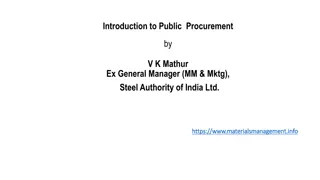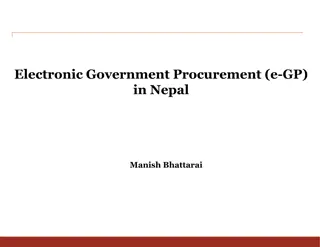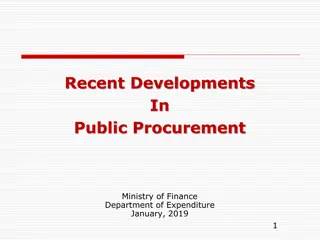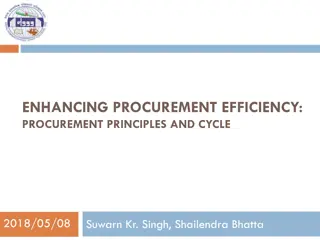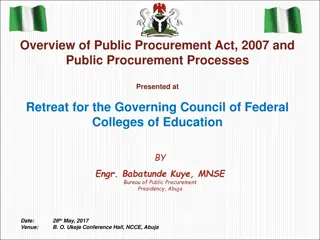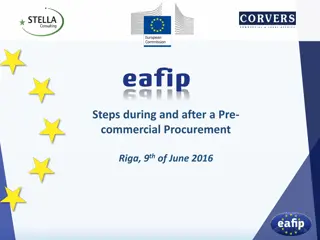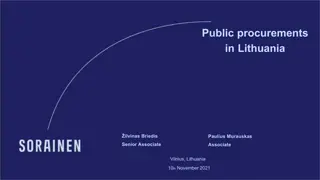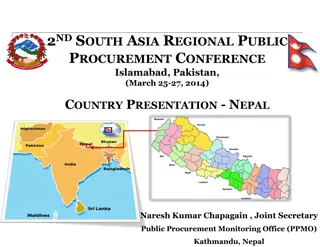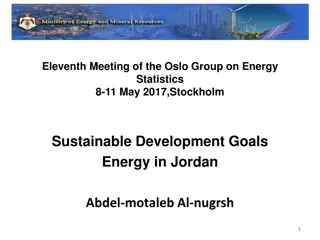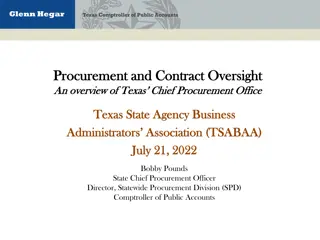Public Procurement Challenges in Energy Sector
Procurement in the energy sector is vulnerable to corruption and mismanagement, with issues like lack of transparency, competition restrictions, and concentration of funds. This hinders fair competition and efficient allocation of resources, impacting economic development and public trust.
Download Presentation

Please find below an Image/Link to download the presentation.
The content on the website is provided AS IS for your information and personal use only. It may not be sold, licensed, or shared on other websites without obtaining consent from the author.If you encounter any issues during the download, it is possible that the publisher has removed the file from their server.
You are allowed to download the files provided on this website for personal or commercial use, subject to the condition that they are used lawfully. All files are the property of their respective owners.
The content on the website is provided AS IS for your information and personal use only. It may not be sold, licensed, or shared on other websites without obtaining consent from the author.
E N D
Presentation Transcript
PUBLIC PROCUREMENT AND CHALLENGES IN THE ENERGY SECTOR MISSMANAGEMENT AND CORRUPT PRACTICES
MAIN CONTENT Transparency challenges Competition restrictions Exclusivity agreements Concentration of public procurement funds
Public procurement as a key economic development tool and also a mean for redistributing national income is highly prone to corruption, fraud, and other forms of abuse of public financial resources. In the energy sector, public procurement plays a substantial role in a number of activities ranging from building multi-billion new power stations and purchasing materials and consumables to awarding consultancy and financial services.
TRANSPARENCY CHALLENGES The lack of transparency in the management of public procurement is one the clearest indicators about bad governance as it prevents taxpayers from understanding the structure of public spending. PP Issues: no or only limited energy-specific public procurement data; no possibility for further comparisons across sectors and countries. Albania: Energy SOEs do not publish sufficient information on the tenders they have issued. There is no open and editable data on the names of the winning companies and the values of the PP for each of them. Serbia: The data on public procurement in the Serbian energy sector is also limited since aggregate data for the entire energy sector does not exist in the Public Procurement Office Montenegro: No energy sector-specific data on public procurement is available online. The annual reports on public procurement of the state-owned enterprises have to be obtained through free access to information.
COMPETITION RESTRICTIONS One common corruption red flag in the region is the general restriction of competition in tendering. The contracting authorities are often imposing exclusive criteria in order to limit the amount of competition for each contract. The exclusive criteria may often fit the profile of a very specific company that could be directly influencing the terms drafting process through the illicit transfer of funds or the capturing of the senior management of the energy SOEs. In some cases, energy contracts could be even exempted from the whole public procurement process. In such cases, good governance principles of transparency, efficiency and competition may be put aside in order to directly allocate contracts to a well-vested private interest.
COMPETITION RESTRICTIONS In terms of competition among the bidders, the procedures for the award of public procurement contracts vary considerably. They fall into three major categories: Non-competitive procedures, where a limited number of bidders are allowed to submit a tender, after which negotiations take place. These include negotiation procedures with and without publication of the contract notice, a competitive dialogue procedure, a negotiation procedure following a special invitation. The extreme case of this procedure could be the direct invitation of a company to execute the contract without the publication of a contract notice. Semi-competitive procedures open for bidding to a limited number of interested parties only by an exclusive invitation from the contracting authorities. Competitive procedures open for tender submission to all interested parties without the inclusion of special terms applicable to only a few companies or in the worst-case scenario, one bidding firm. In fact, in a large number of the energy sector public procurement, only one company has submitted a bid.
COMPETITION RESTRICTIONS In Turkey, Serbia and Albania a common corruption risk has been found in the fact that the energy tenders are implemented outside the general public procurement procedures. Serbia exemption from the Public Procurement Law is provided to several energy companies: the Petroleum Industry of Serbia (NIS), which is owned by Gazprom (Serbia has a minority share); the wholesale gas supplier, Srbijagas, (gas is purchased under a long term agreement with Gazprom); for international agreements too, such as the Serbian-Chinese arrangement for investments in the energy industry; projects fully financed by international financial organizations. International agreements (circumvented PPPs, presenting an additional national security risk related to the increase of foreign state influence in domestic affairs) In Albania energy tenders were also part of extraordinary procedures. This means that the rules for fair and competitive public procurement may be circumvented. In Turkey it is the case that energy, water, transportation and telecommunication projects have been exempted from the scope of the public procurement law. In Montenegro the law prescribes the percentage of use of direct agreement, the non-competitive procedure, to be 10%, however it is common in practice that this percentage is higher. (Case of COTEE Montengero) Macedonia has also reported several cases of problematic PPPs.
COMPETITION RESTRICTIONS Table 1. Macedonia s ELEM Procurement Contracts (2009 2014) Total N. contracts (2009- 2014) No. contracts: 2009 2010 2011 2012 2013 2014 Total Amount (EUR) % Open Procedure 384 406 362 336 214 209 1911 373.432.008 46,8% Restricted Procedure 13 3 5 1 0 0 22 29.253.698 3,7% Negotiated procedure without prior publication of a contract notice 39 37 29 82 137 70 394 106.265.053 13,3% Negotiated procedure with prior publication of a contract notice 3 0 6 3 1 0 13 289.365.123 36,2% TOTAL 439 446 402 422 352 279 2340 798.315.882
COMPETITION RESTRICTIONS The specific nature of the energy sector is conducive to the circumvention of highly competitive procedures. The opaque environment of public procurement in the energy sector is mainly based on: The exclusive criteria for access and safety of energy sites, the effective technology monopoly at the micro level for a number of supplies, the ambiguous legal nature of energy export transactions, the lack of effective in-house financial audits, and the lack of monitoring and control with respect to public procurement efficiency exercised by the energy or any other control body.
COMPETITION RESTRICTIONS The share of open procedures where a single tender has been submitted is indicative of the progressive establishment of discriminatory specifications. Open procedures (competitive procedure types) in principle attract broad interest and the number of submitted tenders would typically be as high as possible. In the energy sector, however, preference is consistently given to non-competitive procedures for the awarding of public procurement contracts. On the other hand, public procurement with single bidding although a competitive procedure type is a serious red-flag for corruption due to at least two factors: entry barriers contracting authorities may have designed such tender specifications especially for a specific company or a combination of companies (which is more often the case) a) b) political embeddedness, i.e. tacit knowledge and relationships that allow politically connected firms to bid in tenders with difficult or impossible requirements that will later be amended or ignored through low implementation controls. b)
EXCLUSIVITY AGREEMENTS The existence of many exclusive agreements in the regional energy sectors reveals additional potential for undue favoritism in the selection of suppliers of goods and services to SOEs. Also, high-priced arrangements may be tolerated in exchange for a counter-offer from the company-provider. The Albanian case shows that public procurement and concession procedures in the energy sector are not obliged by law to be processed via an electronic platform. (OSHEE, GEN-i Tirana) In Montenegro the media attention was directed towards EPCG that has paid more than EUR 15 million for consulting services since 2010, without calling public tender. Furthermore, the High State Audit in Albania discovering favouritism for several companies in public tenders proposed 26 warning measures as well as firing several employees of AlbPetrol for the irregularities observed in the tender procedures, including legal prosecution for the head of the company at the time.
EXCLUSIVITY AGREEMENTS Table 1. Economic damage related to public procurement violations in the energy sector in Albania for the period 2012-2015 Economic Damage in procurement sector (ALL) Economic Damage in procurement sector (EUR) Change in percentage of the economic damage Year 2010 187,573,000 5,692,080 -56.48% 2011 210,324,000 3,146,109 12.13% 2012 444,573,000 1,369,146 111.38% 2013 354,099,000 1,535,212 -20.35% 2014 678,118,000 3,245,058 91.51% 2015 2,621,594,000 2,584,664 286.6% Source: HSA reports 2010-2015
CONCENTRATION OF PUBLIC PROCUREMENT FUNDS The public procurement can be misused in a way that a particular bidder or bidders get the majority of public tenders depicting concentration of the funds. This is deemed problematic as the funds may be misused for political reasons or nepotism. Kosovo Energy Corporation KEK is not only the first contracting energy SOE in terms of value of public procurement contracts in Kosovo for the period 2010-2014, but also the biggest contracting authority in general for the same period. In Macedonia the electricity generation company ELEM, is the biggest contractor.ELEM is the largest contractor in the public procurement in Macedonia and in fact the four largest public procurement contracts in the country are issued by ELEM. This SOE is also connected to a politicised concentration of public procurement funds since most of ELEM s high value contracts are largely concentrated in three suppliers: DGU Pelister Bitola DOO, DGTT Trans Met DOO, DTPU Markovski Kompani DOOEL. They are sharing 51% or EUR 194 million of the mentioned op 100 largest public procurement contracts and total of EUR 217,8 million or 27% of ELEM total public procurement in the period 2009-2014 . BiH s top 10 procurement contractsshow a concentration of these contracts values in the top three winning companies.(Rudnap.d.o.o.; OPTIMA GRUPA d.o.o.; BANOVI I d.d. rudnicimrkoguglja)
CONCENTRATION OF PUBLIC PROCUREMENT FUNDS In Turkey looking at the public procurement data for the 2004-2011 according to G rakar (2015) SOEs account for approximately one-fourth of the total value of all high value procurements.Five SOEs account for 6 percent of the total value of all procurements. Two thirds of this 6 percent share went to politically connected firms such as those with owners/shareholders who are (i) a member of the Parliament from the ruling AKP; ii) an AKP official at the local level such as a provincial head or a member of the provincial party organization; and iii) close relatives/immediate family members of ruling party officials indicated in (i) and (ii). The public procurement data is not fully publicly available in Turkey. The request to PPA to get the full data for the 2009-2014 period was declined.
CONCENTRATION OF PUBLIC PROCUREMENT FUNDS Unnecessary tenders may be an important indicator of corruptive behaviour and misuse of public funds or simply irresponsible public spending. The risk is greater if the procedure is not competitive too. The corruption risks in the analysed region continue with the corruption risk instructions to buy. It means that SOEs may receive instructions to buy certain products or services. These may be overpriced, of insufficient quality or may never be delivered. The 2010 audit carried out by the Office of Kosovo Auditor General recommended to KOSTT Board of Directors to develop clear instructions in order to address identified weaknesses. Poor assessment of tenders was among the main irregularities, namely the value of the most tenders was higher than the market price.The audit reports in the following years (2011, 2012, 2013 and 2014) shows that none of recommendations above have been addressed. Further example of instruction to buy is the corruption case related to EFT in BiH. According to the records collected by the Financial Police of the Federation of Bosnia and Herzegovina (FBiH), the heads of the Sarajevo-based State Company Elektroprivreda Bosnia and Herzegovina (EP BiH) signed a contract to sell power surplus to EFT in 2009. Chances are that the EFT managers will be found guilty of abusing their offices for embezzling around EUR 4.1 million. The issue according to EP BiH is that nearly 50,000 megawatt hours have never been shipped.
For more: Regional Energy Governance and State Capture Assessment Report (August 2016) Policy Brief: Countering Energy Governance and State Capture in SEE and Turkey (Ju ly 2016) Country (SEE and Turkey) Fact Sheets (August 2016) THANK YOU!


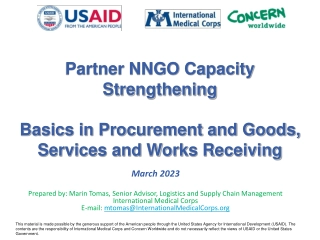
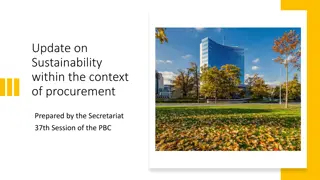


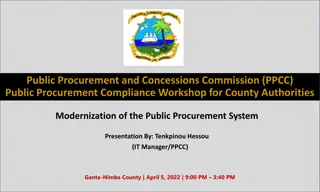
![Comprehensive Overview of Corruption Watch Submission on Public Procurement Bill [B18B-2023]](/thumb/138344/comprehensive-overview-of-corruption-watch-submission-on-public-procurement-bill-b18b-2023.jpg)
